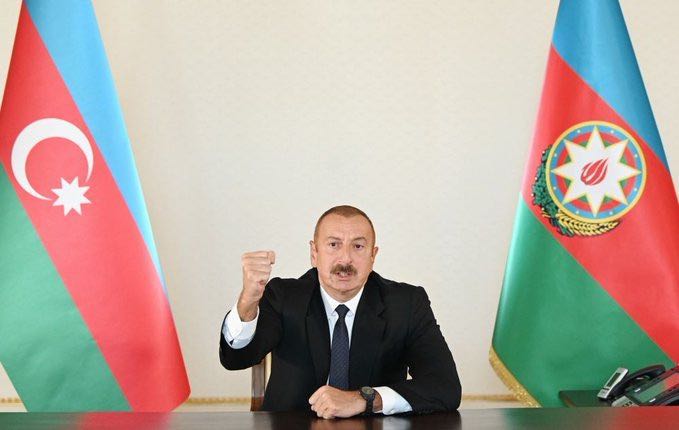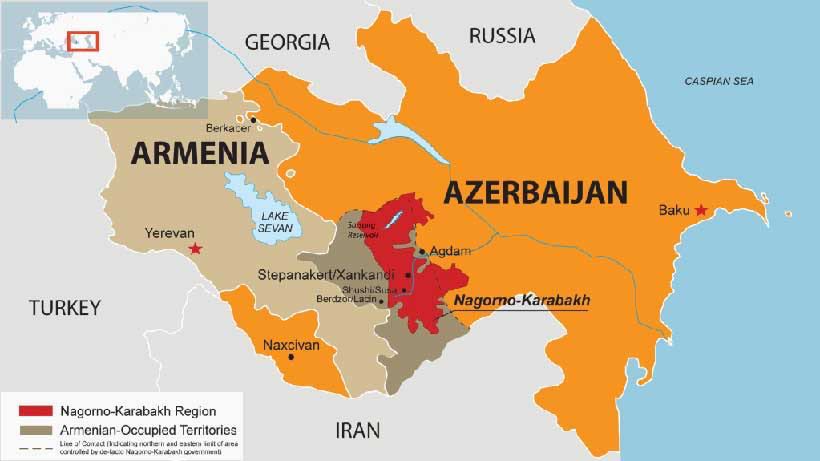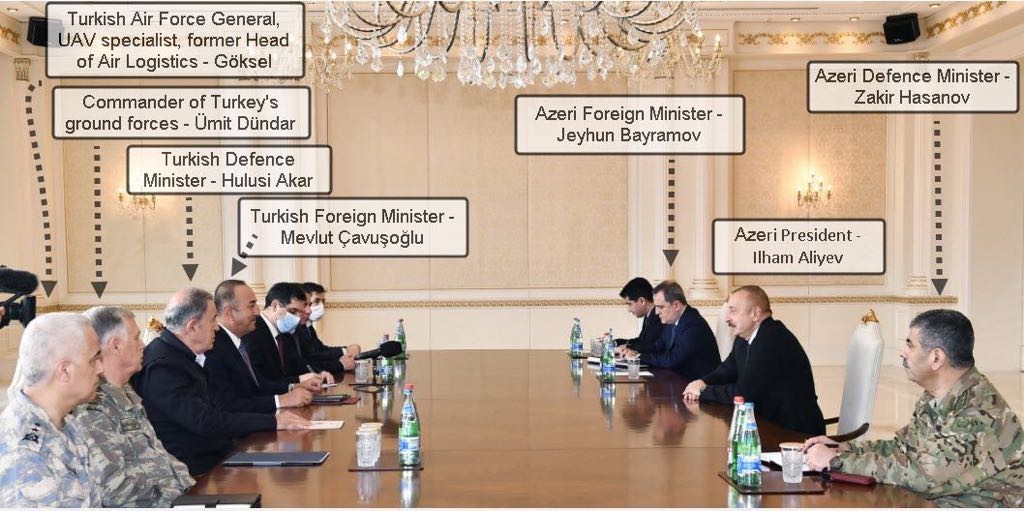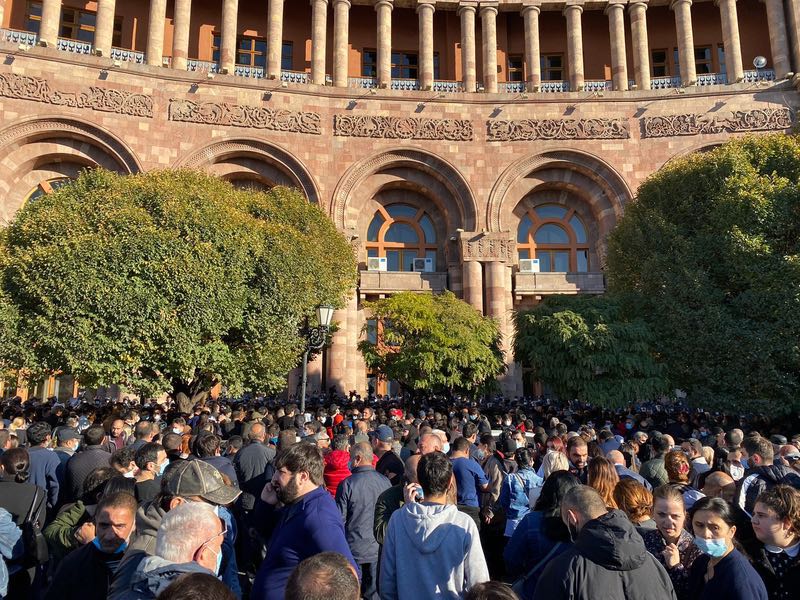Russia, Azerbaijan and Armenia brokered a cease-fire on Karabakh before the Azeri managed to recapture the Armenian enclave of Karabakh. It is a major victory for Azeri president Aliyev and a devastating blow for Armenian PM Pashinyan. Turkey played a big role with its vociferous and military support for Aliyev. Russian peacekeepers already arrived in the region. According to Warsaw based OSW expert Wojciech Górecki it is a win for Russia: the West is out and Turkey officially didn't sign the armistice. However, Turkish troups can be invited to Azerbaijan any time.
 The Azeri president Ilham Aliyev is the big winner of the war on Karabakh
The Azeri president Ilham Aliyev is the big winner of the war on Karabakh
by Wojciech Górecki
On the night of 9-10 November, the Prime Minister of Armenia, Nikol Pashinyan, and the presidents of Azerbaijan and Russia, Ilham Aliyev and Vladimir Putin, signed a statement suspending fighting in the Nagorno-Karabakh conflict zone. This truce presupposes that the warring parties’ forces will remain in their present positions. In addition, by 1 December, Armenia is to hand over to Azerbaijan the areas adjacent to Nagorno-Karabakh, which they have controlled since 1994, with the exception of the five-kilometre belt of the so-called Lachin corridor; this will enable land communication between Yerevan and Stepanakert to continue (see map).
The Russian 15th Mechanised Brigade has been tasked with carrying out peacekeeping activities and is being deployed along the demarcation line; it is made up of 1960 soldiers with the staff equipment, including armoured transporters. The rapid deployment of this unit demonstrates that the decision to use it must have been taken no later than the end of last week.
All roads and communication routes in the region are to be unblocked. This also applies to the road between the main part of Azerbaijan and the Nakhchivan Autonomous Republic which runs through the territory of Armenia (Russian border guards are to control traffic in this section). Refugees and displaced persons are permitted to return to their places of residence. The parties will exchange prisoners and the bodies of the fallen. However, the agreement does not determine the legal status of that part of Nagorno-Karabakh which will remain under Armenian control.

Commentary
1. The ceasefire at the present stage of the fighting, and in the form outlined above, means a triumph for Azerbaijan and the de facto capitulation of Armenia, which is losing most of the territory it occupied in the early 1990s. The immediate deployment of a contingent of Russian peacekeepers in the conflict area – their deployment began in the morning of 10 November – effectively guarantees that the truce will be maintained. It is difficult to imagine that either party would take the risk of initiating an armed confrontation in this situation (although this does not, of course, exclude various types of incidents and provocations). Moscow has strengthened its presence in the South Caucasus region; its peacekeepers are to be stationed on the spot for five years, with the possibility of extending their stay for further five-year periods (with the consent of the warring parties). The deployment of the Russian contingent and its supervision of the transport links which are important to both sides (between Armenia and Nagorno-Karabakh, and between Azerbaijan 'proper' and Nakhchivan) will allow Moscow to keep both countries within its zone of influence.
2. The fact that the statement did not mention Turkey and did not provide any role for it is a severe defeat for Ankara, which – by promoting the resolution of the conflict by military means and supporting Azerbaijan – had hoped to participate in a new format of the peace process which would have allowed it to significantly strengthen its position in the region (in the maximum variant, Ankara envisaged the South Caucasus as a kind of Turkish-Russian condominium). There are many indications that the Kremlin kept Ankara believing that such a scenario was realistic right up until the last moment (as evidenced by the bilateral Russian-Turkish contacts at various levels, which had intensified over recent days), while at the same time it was negotiating the terms of a truce with Baku and Yerevan. The statement by Azerbaijan’s president Ilham Aliyev – who mentioned a 'joint peace mission between Russia and Turkey' and gave his thanks to Recep Tayyip Erdoğan during a phone conference with Vladimir Putin after the declaration was signed – should be treated primarily as an expression of courtesy. However, it seems that Turkey’s participation in the conflict area’s new security architecture will be merely symbolic, and will rely on the presence of its military observers in the future Russian/Turkish-run ceasefire control centre (the creation of which is envisaged in the tripartite declaration). An important plus for Turkey is the prospect of gaining access to Azerbaijan via the route running through Nakhchivan and Armenia.
 Heavy Turkish delegation holding talks with Azeri president Aliyev in Baku on the day of the armistice
Heavy Turkish delegation holding talks with Azeri president Aliyev in Baku on the day of the armistice
3. According to the agreement, all the areas around Nagorno-Karabakh itself (except the Lachin corridor) and the southern part of it, together with the city of Shusha, will return to direct Azerbaijani control after 26 years, while the northern part containing Stepanakert (and the road link with Armenia) will remain under Armenian control. The status of this area has not been specified, and it should be assumed that additional arrangements will be made concerning it in which Azerbaijan’s negotiating position will be incomparably stronger than that of the Armenians. We should expect it to remain formally part of Azerbaijan, and the Armenian enclave will enjoy a disproportionately smaller autonomy than the Nagorno-Karabakh Republic para-state had formerly enjoyed (it can be expected, for example, that this ‘new Nagorno-Karabakh’ will be a demilitarised zone).
4. The agreement will de facto put into effect the majority of the so-called Madrid principles, i.e. the elements for resolving the conflict developed by the OSCE Minsk Group which had generally been accepted by both parties – although it does not refer to them, and does not even mention the name of the Group, which has now lost its raison d’être in the present circumstances. These principles included:
The OSCE Madrid principles:
1. the return of the territories around Nagorno-Karabakh, the so-called ‘occupied territories’, to the control of Azerbaijan (this is planned to happen);
2. the maintenance of the corridor linking Armenia with Nagorno-Karabakh (this should take place);
3. ensuring the right of all refugees and displaced persons to return to their places of previous residence (this should take place);
4. international security guarantees, which will also cover the future peace operation (both the guarantees and the peace operation will be exclusively Russian);
5. granting Nagorno-Karabakh itself temporary legal status, guaranteeing its security and self-governance (this issue remains unclear, but it seems that the essence of this demand will be preserved);
6. the future determination of the final legal status of Nagorno-Karabakh by means of a legally binding expression of will, i.e. a referendum (we should assume that no such referendum will take place; under the changed conditions, it will be replaced by arrangements to be made between Baku and Yerevan, reached through Russian mediation).
5. The Madrid principles, the first draft of which was released back in 2007, have therefore proved to be an appropriate basis for an agreement. The obstacle to their earlier implementation was the reluctance of both sides – especially Armenia, which was satisfied with the status quo – to make concessions, together with a total lack of mutual trust, as well as an absence of will (and instruments) among the external actors to force Baku and Yerevan to accept them. One important deviation from the Madrid rules is the transfer to Azerbaijan of the city of Shusha, located in the heart of Nagorno-Karabakh, which is important for strategic and symbolic reasons (before the 1990s war, most of Shusha’s inhabitants were Azerbaijanis). [Susha was recaptured by Azerbaijan, one of the main reasons for Armenia's capitulation - ed.] The truce signed now provides for the construction of a new road (bypassing Shusha) to link Armenia with Stepanakert, which will remain under Armenian control.
The terms of the ceasefire are an undoubted success for Baku and a humiliating defeat for Yerevan
6. The truce just reached will have a serious impact on the domestic situation in Azerbaijan and Armenia. In the case of the former, it will further strengthen the position of President Aliyev, who has succeeded in bringing an end to the occupation of Azerbaijani lands. The terms of the ceasefire represent an undoubted success for Baku, and the emerging voices of disappointment that the military operation was suspended before control of the whole of Nagorno-Karabakh was regained will be marginalised by the narrative of the displaced persons returning home after almost thirty years of exile (the actual loss of Stepanakert along with the northern part of Nagorno-Karabakh will probably not even be a de jure loss for Azerbaijan: Baku did not control these areas, and their future status will probably take Azerbaijan’s interests into account, while for Armenia the need to give up the ‘occupied territories’ and the rest of Nagorno-Karabakh together with Shusha is a de facto loss).
 Angry protesters in Yerevan demand the dismissal of PM Pashinyan who came to power after mass demonstrations in 2018
Angry protesters in Yerevan demand the dismissal of PM Pashinyan who came to power after mass demonstrations in 2018
In the case of Armenia, the terms of the truce have been perceived as a humiliating defeat. At night, upon the news of the agreement, a crowd gathered on the streets of Yerevan and broke into the prime minister’s office (Pashinyan’s office was demolished). The speaker of parliament, Ararat Mirzoyan, was badly beaten. In the coming days and weeks, very serious internal disturbances are highly probable, and Pashinyan himself may lose power (a situation made more likely because the Kremlin does not trust him). At this stage Armenian society is not ready to accept that the truce just concluded is the lesser of two evils – the war has been stopped, and the presence of Armenians in a part of Nagorno-Karabakh, including Stepanakert, has been guaranteed. The alternative was the expulsion of the entire Armenian population from the territories Azerbaijan had occupied by the end of September, together with an Azerbaijani takeover of the entire Nagorno-Karabakh area, including the monuments of Armenian material culture to be found therein.
This article was first published by Warsaw thinktank OSW.
Analysts wildly disagree about the outcome of the Karabakh war. Who are the winners and who the losers? This twitter-thread by journalist Fabrice Deprez gives all the options.
For historical background on the 100 years old conflict see this article by Thomas de Waal on our website.
